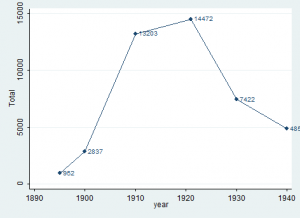It is believed that opium production in Mexico began in the late 19th century and trafficking to the U.S. in the early 20th century. While illegal drug production in Mexico has been under the spotlight for a longtime, immigration knowledge spillovers on such activities are a rather unique way to look at this issue. This summer I worked with Professor Sarah Pearlman and her co-author Emily Owens on a research project focusing on the role that knowledge spillover from Chinese immigration to Mexico played on the development of Mexican opium production.
From reviewing relevant history papers and literatures, we have gained insights about factors contributed to Chinese immigration to Mexico and its geographical distribution. After the British abolishment of slave trade in 1830s, the United States received a large amount of Chinese laborers due to Gold Rush and First Transcontinental Railroad. However, the 1882 Chinese Exclusion Act restricted the entry of Chinese to the United States. Chinese population, especially in California where over 80% Chinese born population in US resided in 1880, experienced a dramatic drop in terms of both total and percentage population. In the meantime, modernization movement in Mexico created domestic labor shortages, resulting in more welcoming immigration policies such as offering citizenship to Chinese migrants. As a result, Chinese population in Mexico showed consecutive increase and reached peak on 1920, according to historical census data from the Instituto Nacional de Estadistica y Geografia (INEGI) in Mexico.
(Total number of Chinese immigrants in Mexico; Source: INEGI)
We analyzed INEGI’s census data from 1895 to 1940 in STATA. We found out that northern states were target destinations of this inflow of Chinese immigration in Mexico, while the majority of total national population at that time was located in the south near Mexico City. Due to social and economic ties between Chinese immigrants in the US (especially California) and Mexico, as well as the fact that Mexico was the first step of illegal entries to the US for some Chinese immigrants, most of destination states are boarder States. For instance, Sonora is at the south of Arizona and Baja California is next to California. We have constructed maps to visually illustrate this concentrated distribution by merging GIS information into STATA
Interestingly, our preliminary assessment of opium poppy cultivation trends in Mexico shows that many popular destinations of Chinese immigrants are now major opium producing states. Chihuahua, Durango and Sinaloa are top states in terms of poppy plant seizures according to Mexican government records in 2005. Since current poppy cultivation is influenced by field visibility, effectiveness of law enforcement, eradication efforts and other factors as poppy cultivation became illegal in 1926, we looked back to historical data about poppy cultivation, preferably before 1930. From Penafiel Yearbook of Mexico obtained from archives in UCLA library, I found municipal level agricultural census of various crops, yet poppy was not recorded. These census data may help us in comparing distributions of poppy and plant whose suitability is similar to poppy. I also found state level opium production from the same documents. Meanwhile, we are trying to construct an index of agro-climatic suitability for poppy in order to locate areas in Mexico that are naturally suitable for poppy cultivation. To aid the research I consulted geography professors and collected maps from atlas and some GIS files.
Although up till now the relationship between immigration and opium production in Mexico remains unclear, throughout the summer we have well traced Chinese immigration inflow to Mexico and understood reasons of this migration, which are essential fundamentals for future research on this topic.


